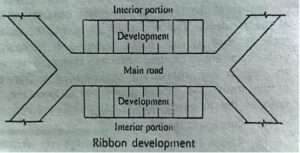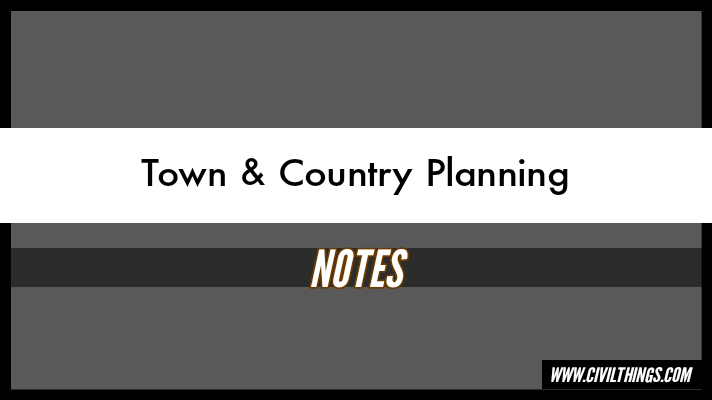Town and country planning Notes, also known as urban planning or city planning, is a discipline that focuses on the design, development, and management of urban areas and their surrounding regions. It involves creating strategies and policies to guide the growth and development of towns, cities, and rural areas in a sustainable and organized manner.
The main objective of town and country planning is to enhance the quality of life for residents and create well-functioning communities. It aims to balance various social, economic, and environmental factors to create livable spaces that meet the needs of current and future generations.
Table of Contents
“This post Helps you to understand the Concept of TOWN & COUNTRY PLANNING Helps to Creck your Diploma and Degree Exams”
Also, Check out
1) Environmental Engineering – Filtration
INTRODUCTION – TOWN & COUNTRY PLANNING
1. Meaning and Scope of the Subject.
Town planning provides the process of organizing and designing the physical layout of a town or city, considering factors such as land use, infrastructure, transportation, and public spaces.
It way to create involving the use of natural products and energy in a way that does not harm the environment, functional, and aesthetically pleasing urban environments while promoting social, economic, and environmental well-being.
The scope of town planning zoning regulations, urban development plans, transportation networks, public amenities, and the overall improvement of quality of life for residents.
1. Evolution of town planning.
- The works of an archaeologist show how the ancient cities were planned. The very simple and not developed men used to stay in tribes & they developed groups for mutual protection for carrying out business activities & for maintaining a social life. The location of the town was also selected by giving some consideration such as ease of defense, climatic conditions, business facilities, etc.
- As such, more cities are as old as civilization seen from the verbal connection between the word ‘city’ and ‘civilization. These two words have merged with the city furnishing the structural framework through which civilization functions. By ‘civilization’, we mean urban civilization. There were people’s groups before that period. But they were initially nomadic, then agricultural, and finally evolved into an urban society.
- The two Designs, pictures, and Drawings of ancient towns are worth mentioning. Kahun in Egypt was conceived & build for a specific purpose before 2500 B.C. It was designed to accommodate workmen & officials engage in the construction of the pyramid at Llahun.
2. Object of town planning.
The four essential objects or ideals of any town planning scheme are Beauty, convenience, environment, and health.
- The object of beauty is achieved by taking the most possible advantages of the natural conditions surrounding it. the town and also by giving architectural finishes to the various components of the town. It also includes the preservation of trees, natural greenery, architectural control on the public as well as semi-public buildings, ancient architectural buildings, temples, churches, mosques, buildings of cultural and historical significance, etc.
- The object of convenience is understood in the form of more economic, social & recreational places to be given to the public. These amenities include cheap power and electricity, proper sites for industrial units, transport facilities, adequate water supply, easy disposal of sewage and industrial wastes, facilities for commercial units, etc. The recreational amenities include open spaces, parks, town halls, playgrounds, cinema houses, community centers, stadiums, etc.
- At this step, it will be worthwhile to understand the meaning of the term urban area. This term is used for a limited area in which a big number of people are permanently rise & then r separated from other centers by a much greater area of thinly populated land. It is also understood that the residents of an urban area r normally, though not wholly, engaged in not agricultural activities or occupations. the urban area r very much a human invention & its primary function is to carry out service activities from a centralized location for the benefit of the surrounding agricultural area.
3. Growth of towns
concentric spread, Ribbon, Satellite development, etc.
The facilities of transportation & communication improve the population & such a tendency leads to the elevation of towns. The means of transport may take up the following forms:
(a) Aerial ports: In some cases, the airports also play an important role in the elevation of a town.
(b) Railways: The town is connected by railways, there will be increases in passengers & good traffic even from long distances.
(c) Roadways: The neighborhood areas connect with the town & it leading to all expansion of trade and industry.
(d) Waterways: If facilities of waterways are available. the town can grow as a harbor with the possibility of foreign trade & business.
The above-mention means of transport have to the horizontal growth of the town. But the availability of mechanical lifts, escalators & elevators has made it possible to have vertical growth of the town in the form of skyscrapers.
The growth of towns & cities can be studied in the following two ways :
- Growth according to the origin
- Growth according to the direction
A.Growth according to origin :
1. Natural growth
2. planned growth
1. Natural growth
Most of the towns in the past have grown naturally, It’s the development of the town as such has taken place without any plan. The men on the spot & the interested parties took decisions regarding the elevation of the town for the immediate comfort & convenience of the resident. The provisions of any essential amenities such as road system. park, playgrounds, schools, industrial units, commercial centers, hospitals, cinemas, etc. R made irregularly without any consideration for future expansion of the town. The natural elevation of a town may be in the form of the following four types:
- Concentric spread
- Ribbon development
- satellite growth
- Scattered growth
Concentric spread:- It is the natural tendency of the people to be as closeted as possible to the town or city & as a result of this tendency, the town develops in the form of concentrate rings with the nucleus as a town Such a growth creates any complicated problems such as traffic congestion, narrow streets, the concentration of population, improper houses, etc.
The town elevation is presented by a series of concentric circles or rings. The first zone embodies the central business district & it’s the special point of commercial, social & civic life of the town area. It represents the area of original settlement & land use in this zone takes the forms of shops, offices, hotels, theatres, etc. As the town grows, the person who can afford high transport time & charges go away from the central zone & this low-income housing, better-class residences, and high-class residences are subsequently formed away from the central business district respectively.
Ribbon development:- It has been observed that because of the elevation of the road surface & elevation of motor traffic, it’s the natural tendency of everyone to build as closest as possible to the main road. The building activity, therefore, expands in a natural way along the sides of the main road and long fingers or ribbons of houses, factories, shops, etc.

If ribbon development is allowed without the enforcement of certain rules and regulations, it leads to the following disadvantages:
(1) As the house extends in a long strip, there is an increase in the cost of various basic utility services such as water supply, electricity, post-delivery, telephone, etc. thus resulting in the wastage of available resources.
(2) The development of ribbons causes them to lose & scatter the group so that there is a lack of social life
(3) future improvement becomes costly & difficult, if not impossible.
(4) The interior part is left undeveloped which results in the wastage of valuable land.
(5) There are chances of traffic accidents & traffic delays because of the presence of pedestrians on the main road.
(6) The ribbon development is purely an urban formation that is thrust into the naturalness of a country & hence, it is aesthetically faulty.
(7) The ribbon development spoils the countryside & if it is carried to the extreme, it would make it non-visible at least to the road user.
(8) The traffic capacity & efficiency of the main road are reduced.
Town & Country Planning Notes

Hi! I’m Sandip, a civil engineer who loves sharing about Civil Engineering & new ideas and tips. My blog helps you learn about engineering in a fun and easy way!


1 thought on “TOWN AND COUNTRY PLANNING | INTRODUCTION AND NOTES”